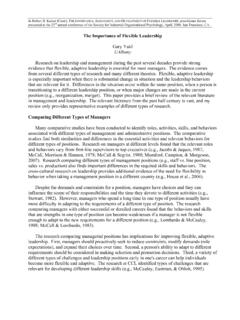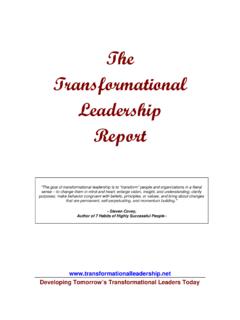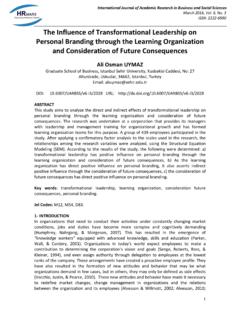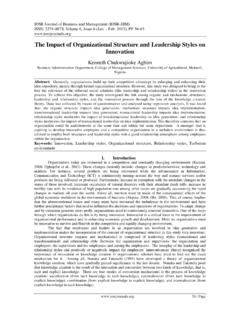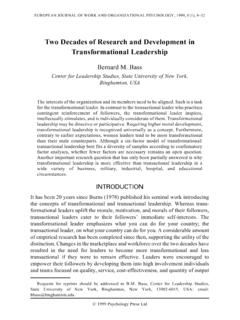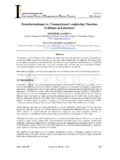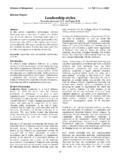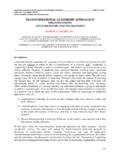Transcription of The Leadership Value Chain - Kaplan DeVries
1 The Psychologist-Manager Journal, 13: 164 183, 2010 Copyright The Society of Psychologists in ManagementISSN: 1088-7156 print / 1550-3461 onlineDOI: Leadership Value ChainRobert B. Kaiser and Darren V. OverfieldKaplan DeVries is little question that Leadership is vital to organizational effectiveness; how-ever, there is a lack of comprehensive models of the processes and interveningfactors that explain the link between individual leaders and organizational perfor-mance. This article concerns an evidence-based framework, theleadership valuechain, that traces the characteristics of individual leaders to their Leadership style; Leadership style to effect on team and unit processes; team and unit processes to teamand unit results; and team and unit results to effectiveness across a broad range oforganizational-level performance measures.
2 The point of the Leadership Value chainis to identify the sequence of key variables and considerations that relate individualleaders to organizational effectiveness. Of all the things to consider, these are thethings that must be considered to determine the Value of Leadership . The authors useexamples to show how this framework can provide a heuristic for thinking strate-gically about key Leadership investment decisions and organizational people take it for granted that Leadership matters. Beyond everyday intuition,research has documented a link between leaders and organizational effective-ness. For example, one study estimated that high performing executives add,on average, $25 million in Value more than mediocre performers over a typi-cal tenure (Barrick, Day, Lord, & Alexander, 1991).
3 Another study concludedthat chief executive officers account for 14% of the variability in firm finan-cial performance (Joyce, Nohria, & Roberson, 2003). To put that in perspective,industry sector accounts for 19% (McGahan & Porter, 1997). Thus, deciding whowill lead is nearly as consequential as deciding whether to sell pharmaceuticals,undergarments, or is one thing to know that leaders play a decisive role in the fate of orga-nizations; it is a different and more helpful thing to know how they make aCorrespondence should be sent to Robert B. Kaiser, Kaplan DeVries Inc., 1903G Ashwood Court,Greensboro, NC 27455. E-mail: By: [Overfield, Darren V.] At: 19:40 11 August 2010 Leadership Value CHAIN165difference.
4 We have searched the business press and the professional literaturefor research-based models that explain how leaders make a difference. There aremany frameworks that capture pieces of the puzzle, but none gives the this article, we propose a framework to begin filling this void. It is called theleadership Value chainbecause the basic concept comes from Value Chain logic(cf. Porter, 1985). The goal is to identify the sequence and classes of variablesthat transform a particular input (individual leaders) into a valued output (organi-zational effectiveness). The purpose is that understanding the Value of leadershipis important yet not well developed. It is also a complex problem. Our goal isto cut through the complexity by distinguishing, amid all of the many differentthings we could consider, what are the essential things we must consider to deter-mine the Value of Leadership ?
5 We also take an evidence-based approach, choosingonly factors demonstrated by empirical research to link leaders, Leadership , andorganizational providing a bit of background, we describe the elements in the leadershipvalue Chain and suggest ways to assess them. Ultimately, we acknowledge limi-tations to the model and close with examples of how consulting psychologists,human resources and talent managers, and researchers can apply the frame-work in thinking strategically about key Leadership investments and interest in Leadership comes from our work in business , much of the following pertains to Leadership in the context of for-profitbusinesses. The basic logic and key concepts are likely to pertain to Leadership ofgovernment, military, education, community, and nonprofit organizations; how-ever, some of the organizational performance variables we discuss may need tobe adapted to those the ComplexThere were two needs that prompted the development of the Leadership valuechain.
6 First, our research and development team needed a way to think about crite-ria for validating new Leadership assessment tools and development , the question of how leaders add Value is on everyone s mind it is centralto such issues as the return on investment of executive coaching and the debateabout executive compensation but the problem seems hopelessly complex. Inexamining both the scholarly and practitioner literatures, we were struck by thelack of a comprehensive framework. This prompted us to attempt to create By: [Overfield, Darren V.] At: 19:40 11 August 2010166 KAISER AND OVERFIELDFair warning: the Leadership Value Chain and the discussion around it are notsimple. This framework goes well beyond a 2 2 matrix.
7 We are forsaking thevalue of simplicity in deference to the complexity of the topic. Our hope is that asone examines the framework by understanding each phase one at a time and thenconsidering how they all link together, one will find what Oliver Wendell Holmesdescribed as the simplicity on the other side of complexity. DefiningLeadershipAll discussions of Leadership rest on an assumption about what the term thinking behind the Leadership Value Chain is guided by the view of leadershiparticulated by Robert Hogan (Hogan, Curphy, & Hogan, 1994; Hogan & Kaiser,2005). According to this view, on the basis of an analysis of human origins, leader-ship is an evolved solution to the adaptive problem of collective effort (Van Vugt,Hogan, & Kaiser, 2008).
8 Fundamentally, Leadership concerns influencing individ-uals to transcend their short-term self-interests and contribute to the long-termperformance of the group. Thus, the essence of Leadership is building a team andguiding it to outperform its are two important points about this definition. First, Leadership doesnot primarily concern individuals called leaders; rather, Leadership is primarilyconcerned with the performance of the collective for which the leader is respon-sible. The second point follows the first and is that an evaluation of leadershipeffectiveness should focus on group foregoing may seem obvious. Yet, a recent study we did suggests itis worth emphasis. We reviewed the research literature and examined howscholars operationally defineleadership effectiveness.
9 We created a classifica-tion system for measures of leader effectiveness and then counted how oftenthey were used in 1,695 statistical analyses conducted with 1,124 independentsamples that included more than 285,000 leaders (Kaiser, Hogan, & Craig,2008). The results were telling of an individual bias: The majority of mea-sures of Leadership effectiveness did not reflect team or group performanceand instead reflected evaluations of the individual leader. Common measuresincluded ratings of the manager s overall job performance, the average ratingacross an inventory of behavioral items or competencies, ratings of potential,being nominated or selected for a Leadership role, and rate of career progres-sion.
10 These variables are more concerned with the individual s career success,and they reveal very little about the performance of his or her team. Moreover,of the minority of studies that did examine team performance, most were con-cerned with team processes ( , subordinate job satisfaction, motivation, andcommitment; group cohesion). The least used measures of leader effectivenessconcerned results group productivity, profitability, customer satisfaction, and By: [Overfield, Darren V.] At: 19:40 11 August 2010 Leadership Value CHAIN167 The point is that even professional researchers often make a mistake in measur-ing the Value added of Leadership by focusing on the leader as the unit of the purpose of Leadership is to unite people and guide them in the pursuit ofa collective purpose, then the bottom line is how the group is doing at reachingthat Leadership Value CHAINF igure 1 presents a visual representation of the Leadership Value Chain .
